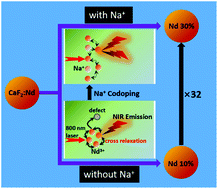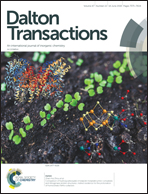Alleviating luminescence concentration quenching in lanthanide doped CaF2 based nanoparticles through Na+ ion doping†
Abstract
Luminescence concentration quenching, mainly due to a cross relaxation (CR) process between lanthanide ions (Ln3+), widely occurs in Ln3+ doped luminescent materials, setting a limit in the dopant content of Ln3+ emitters to withhold the brightness. Here, we introduced Na+ ions into the CaF2 host lattice codoped with Nd3+ emitters that alleviates concentration quenching greatly. And we show that the optimal dopant concentration of Nd3+ in colloidal CaF2:Nd nanoparticles increased from 10 to 30 mol%, resulting in an ∼32 times near-infrared (NIR) (1052 nm) brightness under 800 nm laser irradiation. Our mechanistic investigation suggests that the enhancement of NIR photo-luminescence (PL) could be attributed to not only the increasing crystallinity of nanoparticles but also the reducing concentration quenching of Nd3+ by improving the dopant distribution of Nd3+ ions in the CaF2 lattice, as evidenced by the high angle annular dark field images. These result in the optimal concentration increase to produce brightness enhancement greatly. This strategy can be utilized for other Ln3+ doped CaF2 based nanomaterials for bio-imaging.



 Please wait while we load your content...
Please wait while we load your content...